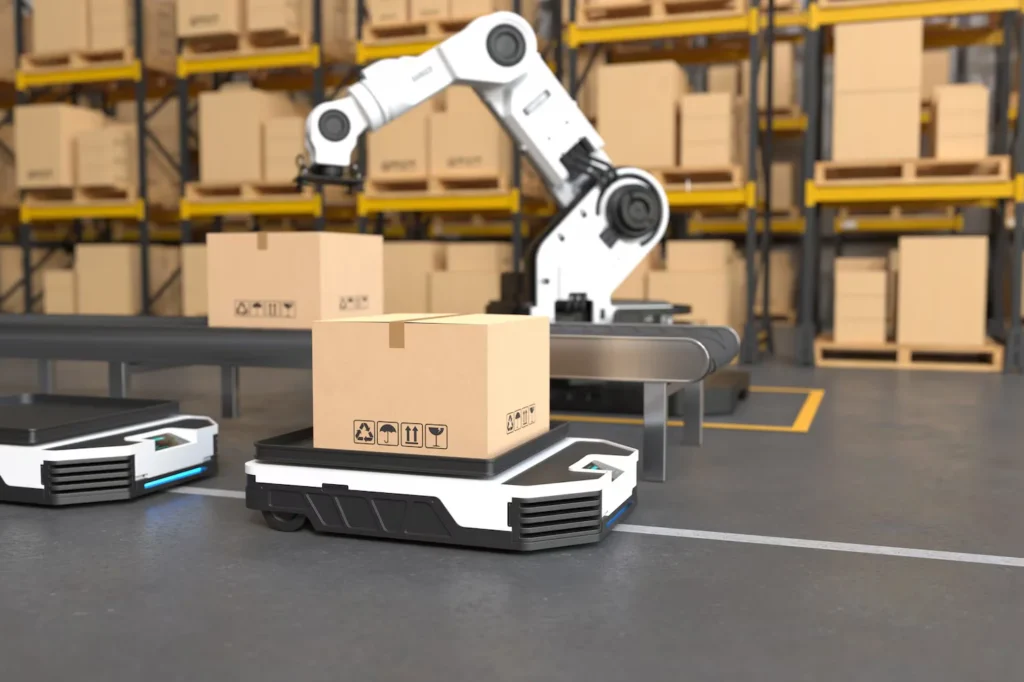In recent years, the rise of robotics in warehousing has ushered in a new era of efficiency and accuracy, transforming traditional storage and fulfillment operations. With e-commerce and supply chains becoming increasingly complex and demanding, the adoption of warehouse robotics has become essential for companies looking to maintain a competitive edge. From increased speed and accuracy to enhanced safety and cost savings, robotics in warehousing offers a range of benefits that redefine operational standards.
Enhanced Speed And Productivity
One of the most significant benefits of robotics in warehousing is the dramatic boost in productivity. Traditional human-led operations are limited by physical capacity and time constraints. In contrast, robots can work around the clock, moving products across the warehouse floor swiftly and efficiently. As an example, autonomous mobile robots (AMRs) and automated guided vehicles (AGVs) are capable of precisely and reliably moving cargo between packaging and storage stations. This eliminates the downtime associated with breaks or shift changes, resulting in higher throughput rates.
A faster workflow is especially beneficial for high-demand periods, such as holiday seasons or flash sales, where customer expectations for rapid delivery are at their peak. By integrating robotics, warehouses can ensure that products are picked, packed, and shipped more quickly, meeting the rising demands for next-day or even same-day delivery.
Improved Accuracy And Reduced Error Rates
Inaccuracies in warehousing—such as picking errors or misplaced inventory—can lead to customer dissatisfaction and costly returns. Warehouse robots are designed to carry out specific tasks with high precision, minimizing human errors in tasks like order picking and inventory management. Technologies such as computer vision and machine learning allow robots to locate and identify items accurately, reducing the likelihood of mistakes in packing orders.
Additionally, robotic systems equipped with sensors and cameras can maintain an accurate real-time inventory count, ensuring that stock levels are consistently up to date. This improved accuracy supports better inventory planning, reducing out-of-stock situations and overstocking, both of which can negatively impact profitability.
Increased Safety And Reduced Workplace Injuries
The deployment of warehouse robotics is essential for improving worker safety. Warehouses are often bustling environments with forklifts, heavy lifting, and constant movement, posing various risks for employees. Robots can take on some of the most physically demanding tasks, such as lifting heavy objects, repetitive movements, or navigating areas with high foot traffic. By handling these tasks, robots reduce the strain on human workers, lowering the risk of common workplace injuries like strains, sprains, and falls.
Moreover, with the deployment of robots for routine and potentially hazardous tasks, workers can focus on more complex, cognitive tasks, reducing their exposure to dangerous situations. As a result, warehouse environments become safer and more employee-friendly, promoting a culture of safety while reducing costs related to workplace injuries.
Cost Savings And Operational Efficiency
While the initial investment in warehouse robotics may seem high, the long-term cost savings are substantial. By minimizing labor costs, reducing errors, and increasing productivity, companies can achieve greater operational efficiency. Robots also help reduce the costs associated with product damages and errors, as their precision in handling goods minimizes wear and tear on products and packaging.
In addition, robotics in warehousing contributes to space optimization. Many automated systems, such as vertical lift modules, can operate in tight spaces, enabling warehouses to maximize available space. This space-saving capacity is particularly beneficial in high-rent areas, where warehouses need to make the most of every square foot. The improved space utilization, in turn, supports inventory expansion, allowing businesses to store and manage more products without needing additional floor space.
Scalability And Flexibility
Another notable advantage of warehouse robotics is the scalability and flexibility they offer. As businesses grow, their warehousing needs expand as well. Because robotic systems can be scaled up or down in response to demand, businesses can increase the number of robots during busy times and decrease the fleet during slower times. This flexibility is especially advantageous for e-commerce companies, where demand can fluctuate significantly throughout the year.
Moreover, robotics can adapt to various types of tasks. For example, some robots specialize in order picking, while others excel in transportation or inventory monitoring. By integrating different types of robots, warehouses can create a versatile system that addresses multiple functions. This adaptability allows companies to respond quickly to changes in market trends and customer expectations.
Data-Driven Decision Making
Robotics in warehousing generates valuable data on daily operations, from the time required to fulfill orders to the location of each item within the warehouse. This data enables warehouse managers to make informed decisions, optimize workflows, and identify bottlenecks in real-time. Advanced analytics can reveal trends, such as popular product areas that may require more frequent replenishment, enabling managers to make proactive adjustments.
Furthermore, predictive maintenance data can identify potential issues with robotic equipment, allowing for timely repairs before problems escalate. Lowering maintenance expenses and downtime guarantees that robots will always work at their best.
Conclusion
The integration of robotics in warehousing marks a revolutionary shift toward improved efficiency, accuracy, and safety. By automating repetitive tasks, optimizing space, and generating actionable data; warehouse robotics enable companies to meet the fast-paced demands of modern supply chains. As technology continues to advance, the future of warehouse robotics looks promising, with even more sophisticated robots on the horizon that can handle complex tasks and work seamlessly alongside human workers.
In the long run, adopting robotics in warehousing not only enhances profitability but also creates a safer and more productive environment for employees. For businesses looking to stay competitive, the investment in robotics is more than justified—it’s essential for achieving sustained growth in a rapidly evolving industry.







